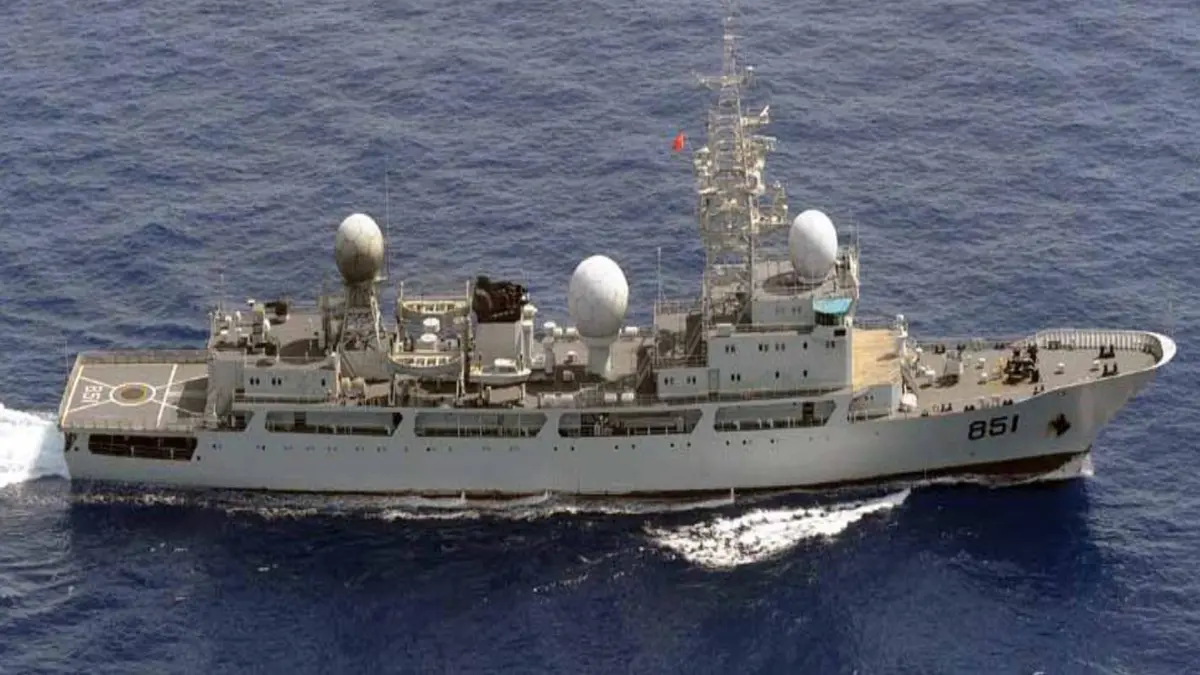China’s Type 815A reconnaissance ships continue to play a role in providing intelligence at sea and beyond the horizon for the People’s Liberation Army Navy (PLAN). Ships such as the Yuhengxing (hull 798) and Qiangxing (hull 796) have cast a shadow over international naval formations – including U.S., Philippine and French warships – during multinational exercises in the South and East China Seas. Their presence has prompted evasive responses from foreign forces operating in disputed maritime areas.
In July, the Tianwangxing (hull 793) was spotted 69 nautical miles off the coast of the western Philippines during the Cop Thunder exercise, not responding to radio alerts from the Philippine Coast Guard. That deployment was supported by a China Coast Guard cutter and a Type 052D destroyer.
Type 815A: Surveillance Tech from Sea to Space
The Type 815A is a refined version of China’s Dongdiao-class intelligence collection platform. Commissioned between 2017 and 2018, these 6,000-ton ships feature a prominent cylindrical radome with a flat top, multiple surveillance domes, missile-tracking radars, and electronic signals intelligence (SIGINT) systems. Versions include Qiangxing, Megrez, Elioth, and Mizar, each assigned to a different fleet command.
Designed to track ballistic missile trajectories and monitor electronic emissions from surface ships and aircraft, the 815A’s sensors enable continuous maritime domain awareness during major defense exercises and missile launches.

- The PLAN Type 815G surveillance ship Tianlangxing (Sirius) is part of China’s Dongdiao-class (NATO designation) of electronic surveillance ships. The Type 815 series, which includes the upgraded 815G and 815A variants, supports PLA Navy intelligence-gathering operations. (Japanese MoD)
Strategic consequences and operational impact
Disruption of stealth and EW exercises
During Cop Thunder – a joint US-Philippines air combat exercise – the collection of radar and telemetry data from a reconnaissance ship helped the PLA map adversary stealth tactics and electronic warfare signatures.
Pressure on evasive maneuvers
Foreign ships and aircraft altered course or frequency-use protocols to reduce tracking from 815A, particularly during sensitive exercises involving F-35A stealth fighters.
Expanding Maritime Intelligence Architecture
The Type 815A’s capabilities complement China’s extensive surveillance infrastructure – including SIGINT aircraft, space-based assets, and coastal radars – enabling a hybrid sea-to-space targeting and analysis loop.
Regional Responses and Escalating Countermoves
Japan’s Ministry of Defense reported regular tracking of Type 815A vessels entering Japanese territorial waters for more than 350 days in 2024 – marking a new operational baseline. Each intrusion prompted the JMSDF to task the ship with shadowing and broadcasting warnings, although the Chinese ships often remained unresponsive.
U.S. The Navy and Japanese forces now explicitly exercise with electronic counter-detection elements, including emission control and deceptive signal analysis, to reduce the surveillance effectiveness of these ships.

- South Sea Fleet (Southern Theater Command) Type 815G and Type 815A intelligence-gathering ships anchor at Yulin Naval Base (Longpo Naval Base) on Hainan Island. (隐世高人/Wikimedia)
Broad implications for maritime stability
Intelligence and surveillance competition
China is building a surveillance advantage that blurs traditional naval boundaries, combining underwater, surface, air, and orbital sensors to collect integrated intelligence.
Operational friction between navies
The regular presence of reconnaissance ships near sensitive exercises has led to friction – and in many cases, diplomatic protests – from Japan, the Philippines, and allied navies operating in the area.
Gaps in arms control and enforcement
Despite operating outside recognized territorial waters, Type 815A ships have sometimes supported Coast Guard vessels entering disputed zones – raising questions about the limits of enforcement and gray-zone confrontation.
Conclusion
China’s deployment of Type 815A reconnaissance ships represents a strategic leap forward in maritime surveillance. By shadowing foreign navies and missile tests with low observability and high-sensitivity tracking systems, these ships have enabled the PLA Navy to observe and analyze modern naval operations in real time. In response, regional navies are adapting operations and countermeasures to eliminate that edge. As these platforms become fixtures in the strategic seas, vigilant surveillance and resilience-building will define response strategies.
Read More: Iranian Proxies Largely Dormant in Israel–Iran War, Experts Say
FAQs
The Type 815A ships are China’s advanced surveillance ships used by the PLA Navy. They collect intelligence on ships, aircraft, and missile tests. The ships track radar signals, electronic signals, and missile paths, giving China a major advantage in monitoring naval activities. Their presence near the U.S., Japanese, and Philippine fleets demonstrates their role in monitoring regional operations.
When Type 815A ships are close to military exercises, foreign navies often change course, adjust radar frequencies, or use stealth measures to avoid detection. For example, during the Cop Thunder exercises, US and Philippine forces had to modify operations to hide F-35A stealth fighter movements from these spy ships.
Yes. Countries like Japan, the US and the Philippines track these ships closely and sometimes even issue warnings. Japan reported more than 350 days in 2024 where Type 815A ships entered waters near Japan, prompting regular shadowing by the JMSDF. Regional navies are also improving electronic countermeasures to reduce China’s spying capabilities.
China’s Type 815A ships represent a new level of surveillance that combines sea, air and space tracking. This creates more tension and friction between navies and raises questions about gray-zone operations in disputed areas. Regional forces now need smarter strategies, better countermeasures, and stronger oversight to maintain security.








Leave a Reply